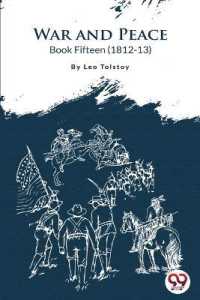- ホーム
- > 洋書
- > 英文書
- > History / World
Full Description
A sweeping and comprehensive history of Prague--from its origins in the ninth century to the present day--that traces its past as a political center and a city on the periphery of empires.
Poets have called Prague the City of One Hundred Spires, Golden Prague, Magic Prague, and the Mother of Cities. Millions of tourists visit the Czech capital each year, awed by the blend of architectural styles and the dramatic landscape. St. Vitus's Gothic cathedral towers above the Charles Bridge and the Vltava River. Winding Gothic alleys lead to elegant squares lined with Renaissance palaces, Baroque statues, and modern glass structures. Yet, the city's beauty often obscures centuries of ethnic and religious conflict. In Prague's Jewish Quarter, the names of nearly 80,000 Holocaust victims are inscribed on the walls of Pinkas Synagogue, which stands as a reminder of a complex and violent past.
Cynthia Paces traces the history of Prague since the late ninth century, when Slavic dukes built the first church and fortifications on the castle hill. Over the course of eleven centuries, Prague vacillated between a political center and a city on the periphery of empires. The Holy Roman Emperors Charles IV and Rudolph II transformed Prague into a European center of arts, politics, and pilgrimage, but centuries of religious conflict, the defenestrations of Prague, and the Thirty Years War threatened to destroy the city. In the twentieth century, Prague was hailed as a beacon of democracy, led by philosopher presidents T. G. Masaryk and Václav Havel, but its citizens also endured violent antisemitism, a Nazi occupation, and a repressive communist regime.
While illuminating a millennium of political, cultural, and social developments, Prague: The Heart of Europe captures the lives of the men and women who have called the city home. Prague has housed Europe's largest Jewish community, a diverse population of German and Czech speakers, and artisans from all over Europe. This sweeping book highlights the manifold contributions of Prague's artists, architects, musicians, and writers. In doing so, it reveals why the city captivated so many creative men and women, including Wolfgang Amadeus Mozart, Antonín Dvorák, Oskar Kokoschka, the poet Elizabeth Weston, and the alchemist John Dee. As Prague native Franz Kafka once wrote, "Prague does not let go; this little mother has claws."
Contents
Acknowledgments
A Note on Language
Timeline of Prague History
Introduction: All this is Prague
Chapter 1: Prague's Foundations
Chapter 2: The Imperial Capital of Charles IV
Chapter 3: Faith and Violence in Wenceslas IV's Prague
Chapter 4: Hussite Wars and New Dynasties
Chapter 5: Rudolphine Prague
Chapter 6: Revolt and Defeat in Habsburg Prague
Chapter 7: Enlightened Prague
Chapter 8: Creating a Czech City
Chapter 9: Prague in a New Century
Chapter 10: The Great War and the Birth of Czechoslovakia
Chapter 11: Capital of the Republic
Chapter 12: Prague under Nazi Rule
Chapter 13: Prague Winter, Prague Spring
Chapter 14: Communism's Gray Zone
Chapter 15: Post-Communist Prague
Notes
Bibliography
index







